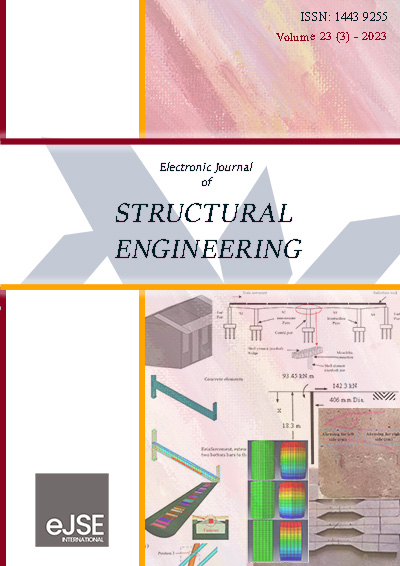Parameters Affect Flexural Mechanism to Prevent Progressive Collapse of RC Buildings
DOI:
https://doi.org/10.56748/ejse.234403Keywords:
progressive collapse, reinforced concrete, flexural mechanismAbstract
This study investigates the effect of spans length, reinforcement ratio and continuity of flexural reinforcement on the progressive collapse performance of double span beams over failed columns. The investigations focus on initial flexural resisting mechanism to prevent the progressive collapse. Detailed nonlinear finite element simulation of double span beam-column sub-assemblages subjected to residual gravity loads that initially carried by the failed column is adopted for the investigations. Nonlinear static pushover analysis is conducted in which capacity curves are derived and compared with demanded capacities. The effect of spans length, reinforcement ratio and number of continuous bottom flexural reinforcement on progressive collapse are considered in the investigations. Analysis results show that the strength to resist progressive collapse has decreased by 25.4 % and the ductility increased by 103 % following the increasing in span length from 5 m to 7 m. On the other hand, increasing reinforcement ratio of top flexural reinforcement from 0.447 to 1.089 leads to 26.27 % increasing in strength accompanied with a decrease in ductility equal to 16.42 %. In addition, extending all bottom bars rather than the minimum specified two bars resulted in 12 % increasing in strength and 40.28 % decreasing in ductility.
Downloads
References
ACI 318-19. (2019), “Building Code Requirement for Structural Concrete” American Concrete Institute, Farmington Hill, MI.
Alogla, K., L. Weekes, and L. Augusthus-Nelson. 2016. “A new mitigation scheme to resist progressive collapse of RC structures.” Constr. Build. Mater., 125: 533–545. Elsevier. https://doi.org/10.1016/j.conbuildmat.2016.08.084. DOI: https://doi.org/10.1016/j.conbuildmat.2016.08.084
Alrudaini, T. M. S. 2021. “Required ties in continuous RC beams to resist progressive collapse by catenary action.” Struct. Eng. Mech., 78 (4): 403–411. Techno-Press. https://doi.org/10.12989/sem.2021.78.4.403.
Alrudaini, T. M. S., and Z. M. Najem. 2016. “The Effect of Column Axial Load on the.” Int. J. Innov. Res. Sci. Eng. Technol., 5 (2012): 5124–5129.
ASCE, 2022, Minimum Design Loads for Buildings and Other Structures. American Society of Civil Engineers, ASCE 7-22, Reston, VA.
Azim, I., J. Yang, S. Bhatta, F. Wang, and Q. feng Liu. 2020. “Factors influencing the progressive collapse resistance of RC frame structures.” J. Build. Eng. Elsevier. DOI: https://doi.org/10.1016/j.jobe.2019.100986
Choi, H., and J. Kim. 2011. “Progressive collapse-resisting capacity of RC beam–column sub-assemblage.” Mag. Concr. Res., 63 (4): 297–310. Thomas Telford Ltd. DOI: https://doi.org/10.1680/macr.9.00170
Committee, A. C. I. 2019. “ACI 318-19: Building Code Requirements for Structural Concrete and Commentary.” Am. Concr. Inst. Farmingt. Hills, MI, USA.
Deng, X.-F., S.-L. Liang, F. Fu, and K. Qian. 2020. “Effects of High-Strength Concrete on Progressive Collapse Resistance of Reinforced Concrete Frame.” J. Struct. Eng., 146 (6): 04020078. American Society of Civil Engineers. https://doi.org/10.1061/(asce)st.1943-541x.0002628. DOI: https://doi.org/10.1061/(ASCE)ST.1943-541X.0002628
DoD, U. 2009. Unified facilities criteria: design of buildings to resist progressive collapse. UFC 4-023-03. United States Department of Defense.
Doran, B., H. O. Koksal, Z. Polat, and C. Karakoc. 1998. “Use of `Drucker-Prager criterion’ in the analysis of reinforced concrete members by finite elements.” Tek. Dergi/Technical J. Turkish Chamb. Civ. Eng., 9 (DEC.): 489–493.
Elkholy, S., A. Shehada, and B. El-Ariss. 2022. “Effects of Floor System on Progressive Collapse Behavior of RC Frame Sub-Assemblages.” Buildings, 12 (6): 737. Multidisciplinary Digital Publishing Institute. https://doi.org/10.3390/buildings12060737. DOI: https://doi.org/10.3390/buildings12060737
Eren, N., E. Brunesi, and R. Nascimbene. 2019. “Influence of masonry infills on the progressive collapse resistance of reinforced concrete framed buildings.” Eng. Struct., 178: 375–394. Elsevier. https://doi.org/10.1016/j.engstruct.2018.10.056. DOI: https://doi.org/10.1016/j.engstruct.2018.10.056
Gsa, U. 2003. “Progressive collapse analysis and design guidelines for new federal office buildings and major modernization projects.” Washington, DC.
Hadi, M. N. S., and T. M. S. Alrudaini. 2011a. “A new system for reinforced concrete buildings to prevent potential progressive collapse.” Inc. Sustain. Pract. Mech. Struct. Mater. - Proc. 21st Aust. Conf. Mech. Struct. Mater., 173–177. CRC Press. DOI: https://doi.org/10.1201/b10571-31
Hadi, M. N. S., and T. M. S. Alrudaini. 2011b. “Preventing the progressive collapse of reinforced concrete buildings.” Proc. 13th Int. Conf. Civil, Struct. Environ. Eng. Comput.
Hadi, M. N. S., and T. M. S. Alrudaini. 2012. “A new cable system to prevent progressive collapse of reinforced concrete buildings.” Struct. Congr. 2012 - Proc. 2012 Struct. Congr., 257–267. DOI: https://doi.org/10.1061/9780784412367.024
Hashemi Rezvani, F., A. M. Yousefi, and H. R. Ronagh. 2015. “Effect of span length on progressive collapse behaviour of steel moment resisting frames.” Structures, 3: 81–89. Elsevier. https://doi.org/10.1016/j.istruc.2015.03.004. DOI: https://doi.org/10.1016/j.istruc.2015.03.004
Helmy, H., H. Salem, and S. Mourad. 2012. “Progressive collapse assessment of framed reinforced concrete structures according to UFC guidelines for alternative path method.” Eng. Struct., 42: 127–141. Elsevier. DOI: https://doi.org/10.1016/j.engstruct.2012.03.058
Iribarren, B. S., P. Berke, P. Bouillard, J. Vantomme, and T. J. Massart. 2011. “Investigation of the influence of design and material parameters in the progressive collapse analysis of RC structures.” Eng. Struct., 33 (10): 2805–2820. Elsevier. DOI: https://doi.org/10.1016/j.engstruct.2011.06.005
Kim, J., J. Yu, and J. Yu. 2013. “Discussion: Analysis of reinforced concrete frames subjected to column loss.” Mag. Concr. Res. Thomas Telford Ltd. DOI: https://doi.org/10.1680/macr.12.00171
Li, Y., X. Lu, H. Guan, and L. Ye. 2014. “Progressive collapse resistance demand of reinforced concrete frames under catenary mechanism.” ACI Struct. J., 111 (5): 1225–1234. https://doi.org/10.14359/51687029. DOI: https://doi.org/10.14359/51687029
Liu, J. L. 2010. “Preventing progressive collapse through strengthening beam-to-column connection, Part 1: Theoretical analysis.” J. Constr. Steel Res., 66 (2): 229–237. Elsevier. https://doi.org/10.1016/j.jcsr.2009.09.006. DOI: https://doi.org/10.1016/j.jcsr.2009.09.006
Panahi, S., and S. M. Zahrai. 2021. “Performance of typical plan concrete buildings under progressive collapse.” Structures, 31: 1163–1172. Elsevier. https://doi.org/10.1016/j.istruc.2021.02.045. DOI: https://doi.org/10.1016/j.istruc.2021.02.045
Weng, J., C. K. Lee, K. H. Tan, and N. S. Lim. 2017. “Damage assessment for reinforced concrete frames subject to progressive collapse.” Eng. Struct., 149: 147–160. Elsevier. https://doi.org/10.1016/j.engstruct.2016.07.038 DOI: https://doi.org/10.1016/j.engstruct.2016.07.038
Downloads
Published
How to Cite
Issue
Section
License
Copyright (c) 2023 Z.M. Najem , Thaer Alrudaini

This work is licensed under a Creative Commons Attribution 4.0 International License.







